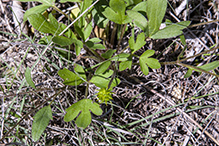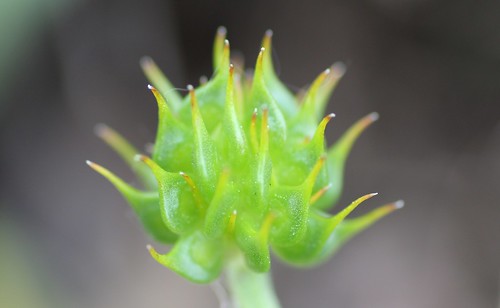early buttercup
(Ranunculus fascicularis)
Conservation • Wetland • Description • Habitat • Ecology • Use • Distribution • Taxonomy
Description |
||
Early buttercup is an early spring wildflower. It occurs in the United States and southern Canada east of the Great Plains. In Minnesota it is scattered to common in the lower third of the state, local and uncommon to absent in the middle third, and absent in the northern third. It is found in open upland woodlands, woodland openings, savannas, prairies, pastures, farmyards, lawns, railroads, and roadsides. It grows under full sun to partial shade, on rocky or sandy soil that is poor in nutrients and where there is little competing vegetation. It is the earliest buttercup to bloom, and one of the first of all wildflowers to bloom in the spring. This is the feature that gives the plant its common name. Early buttercup is a 4″ to 12″ (10 to 30 cm) tall, erect, perennial forb that rises on basal leaves and one or more leafy flowering stems from thickened (tuberous) roots and thin fibrous roots. In late season the tubers can be up to 2″ (5 cm) long. The plant sometimes appears alone but often grows in tufts. Basal leaves are on slender, up to 4″ (10 cm) long leaf stalks (petioles). The petioles are moderately to densely covered with silky, spreading and/or appressed hairs. Leaves are 13⁄16″ to 1⅞″ (21 to 47 mm) long, ¾″ to 1¾″ (19 to 45 mm) wide, broadly egg-shaped in outline, and pinnately divided into 3 or 5 primary leaflets. The leaflets may be undivided, have 2 to 5 lobes, or sometimes be cut into 2 to 5 secondary leaflets. The ultimate segments are inversely lance-shaped or inversely egg-shaped. They are usually angled or tapered, sometimes rounded at the base, and usually have a rounded, acute or obtuse point at the tip. The margins are usually toothless but occasionally have a few teeth near the tip. The upper and lower surfaces may be hairless or covered with silky hairs. Basal leaves are present at flowering time. Stem leaves are smaller, alternate, and stalkless or on short petioles. They may be undivided or cut into 3 lobes or leaflets. The upper and lower surfaces are hairy. The ultimate segments are narrowly oblong or narrowly inversely lance-shaped. The margins are usually untoothed. The stems are erect or ascending and moderately to densely covered with silky, spreading and/or appressed hairs, especially toward the base. They do not root at the nodes, are not thickened at the base, and do not have bulbils. The inflorescence is usually a single flower, sometimes 2 to 4 flowers, each one at the end of a long stalk (peduncle) at the top of the stem. The peduncle is hairy and up to ¾″ (20 mm) long. Each flower is ½″ to 1″ (12 to 25 mm) wide. There are 5 outer floral leaves (sepals), usually 5 petals, rarely up to 8 petals, and numerous stamens. At the center of the flower there is a dense cluster of greenish pistils (carpels). The sepals are green or yellowish-green, 3⁄16″ to ¼″ (5 to 7 mm) long, and 1⁄16″ to ⅛″ (2 to 3 mm) wide. They are widely spreading at first, becoming strongly bent backward near the base and hanging downward with age. They are more or less flat, with no transverse fold, and are usually hairy, sometimes hairless. They drop off soon after the flower is fully expanded (anthesis). The petals are yellow, glossy, widely spreading, and much longer than the sepals. They are oblong to oblong-elliptic, 5⁄16″ to 9⁄16″ (8 to 14 mm) long, and ⅛″ to ¼″ (3 to 6 mm) wide. The stamens form a ring around the base of the cluster of pistils. The stamen stalks (filaments) are yellowish and hairless. The anthers are yellow. Each pistil has a single tiny style. Each carpel has an up to ⅛″ (4 mm) long beak. The fruit is a dry seed capsule (achene) replacing each pistil. As the achenes begin to develop, the petals and sepals fall to the ground, leaving an egg-shaped to more or less globe-shaped, 3⁄16″ to ⅜″ (5 to 9 mm) long, 3⁄16″ to 5⁄16″ (5 to 8 mm) wide seed head. Each achene is shaped like a swollen or inflated lentil, 1⁄16″ to ⅛″ (2.0 to 2.8 mm) long and 1⁄16″ (1.8 to 2.2 mm) wide. The upper margin is sharply angled, forming a narrow rib. The faces are smooth and hairless. There is a 1⁄16″ to ⅛″ (2.0 to 2.8 mm) long extension (beak) at the end of the achene. The beak is slender and straight. |
||
Height |
||
4″ to 12″ (10 to 30 cm) |
||
Flower Color |
||
Yellow |
||
Similar Species |
||
Habitat |
||
Moderately moist to dry. Open upland woodlands, woodland openings, savannas, prairies, pastures, farmyards, lawns, railroads, and roadsides. Full sun to light shade. Poor, rocky or sandy soil, |
||
Ecology |
||
Flowering |
||
April and May |
||
Pests and Diseases |
||
|
||
Use |
||
Toxicity |
||
Most members of the genus Ranunculus, including early buttercup, are poisonous. They contain ranunculin, which causes blistering in the mouth and in the gastrointestinal tract when eaten. Handling the plants causes ranunculin to be broken down into protoanemonin, which causes contact dermatitis. |
||
Distribution |
||||
|
Sources Biodiversity occurrence data published by: Minnesota Biodiversity Atlas (accessed through the Minnesota Biodiversity Atlas Portal, bellatlas.umn.edu, 4/14/2022). |
|||
| 4/14/2022 | ||||
Nativity |
||||
Native |
||||
Occurrence |
||||
Scattered to common in the lower third of the state, local and uncommon to absent in the middle third, and absent in the northern third. |
||||
Taxonomy |
|||
| Kingdom | Plantae (Plants) | ||
| Subkingdom | Pteridobiotina | ||
| Phylum | Tracheophyta (Vascular Plants) | ||
| Class | Magnoliopsida (Dicots) | ||
Order |
Ranunculales (Buttercups, Poppies, and Allies) | ||
Family |
Ranunculaceae (Buttercup) | ||
| Subfamily | Ranunculoideae (Anemones, Buttercups, Larkspurs, and Allies) | ||
| Tribe | Ranunculeae | ||
Genus |
Ranunculus (Buttercups) | ||
Subordinate Taxa |
|||
Some authors recognize two varieties, var. apricus, with basal leaves divided into wide shallow lobes or teeth, and var. typicus, with basal leaves divided into 3 to 5 leaflets. Of these, only var. typicus occurs in the northern half of the United States. Most authors reject the separation and treat the varieties as synonyms. |
|||
Synonyms |
|||
early buttercup (Ranunculus fascicularis var. apricus) early buttercup (Ranunculus fascicularis var. typicus) |
|||
Common Names |
|||
early buttercup prairie buttercup prairie tufted buttercup thick-root buttercup tufted buttercup |
|||
Glossary
Achene
A dry, one-chambered, single-seeded seed capsule, formed from a single carpel, with the seed attached to the membranous outer layer (wall) only by the seed stalk; the wall, formed entirely from the wall of the superior ovary, does not split open at maturity, but relies on decay or predation to release the contents.
Ascending
Growing upward at an angle or curving upward from the base.
Beak
In plants: A comparatively short and stout, narrow or prolonged tip on a thickened organ, as on some fruits and seeds. In insects: The protruding, tubular mouthpart of a sucking insect.
Bulbil
A small bulb, formed in a leaf axil or at the base of a stem, that can produce a new plant.
Carpel
The female reproductive organ of a flower, consisting of an ovary, styles, and stigmas.
Elliptic
Narrowly oval, broadest at the middle, narrower at both ends, with the ends being equal.
Filament
On plants: The thread-like stalk of a stamen which supports the anther. On Lepidoptera: One of a pair of long, thin, fleshy extensions extending from the thorax, and sometimes also from the abdomen, of a caterpillar.
Oblong
Two to four times longer than wide with nearly parallel sides.
Peduncle
In angiosperms, the stalk of a single flower or a flower cluster; in club mosses, the stalk of a strobilus or a group of strobili.
Petiole
On plants: The stalk of a leaf blade or a compound leaf that attaches it to the stem. On ants and wasps: The constricted first one or two segments of the rear part of the body.
Pinnate
On a compound leaf, having the leaflets arranged on opposite sides of a common stalk. On a bryophyte, having branches evenly arranged on opposite sides of a stem.
Sepal
An outer floral leaf, usually green but sometimes colored, at the base of a flower.
Tuber
An underground root (as with dahlias) or stem (as with potatoes), thickened by the accumulation of reserved food (usually starch), which serves for food storage and vegetative propagation.
Do Not Disturb
Another common name for early buttercup is thick-root buttercup. The thickened, tuberous roots are a strong identifying feature. However, uprooting it to observe this feature will kill this perennial plant. Identify early buttercup by its small size; relatively large flowers; pinnate, deeply lobed leaves; flat sepals; straight beak on the achenes; and early blooming period.
Visitor Photos |
|||||
Share your photo of this plant. |
|||||
| This button not working for you? Simply email us at info@MinnesotaSeasons.com. Attach one or more photos and, if you like, a caption. |
|||||
Nancy Falkum |
|||||
first Early Buttercup |
|||||
 |
|||||
MinnesotaSeasons.com Photos |
|||||
Plant |
|||||
 |
|||||
Leaves |
|||||
 |
 |
||||

Visitor Videos |
|||
Share your video of this plant. |
|||
| This button not working for you? Simply email us at info@MinnesotaSeasons.com. Attach a video, a YouTube link, or a cloud storage link. |
|||
Other Videos |
|||
| Early Buttercup (Ranunculus fascicularis) PrairieMoonNursery |
|||
About
Jun 4, 2010 http://www.prairiemoon.com - The earliest Buttercup to bloom at Prairie Moon Nursery is the Early Buttercup with its yellow flowers. |
|||
| Woodland Edge: Early Buttercup Sanders' Wildflowers |
|||
About
Mar 3, 2020 Enjoy a collection of educational videos by Dr. Roger Sanders about the spring wildflowers found throughout the southern Appalachians. These videos are a production of Core Academy of Science, a christian nonprofit based out of Dayton, TN. |
|||

Visitor Sightings |
|||||
Report a sighting of this plant. |
|||||
| This button not working for you? Simply email us at info@MinnesotaSeasons.com. Be sure to include a location. |
|||||
| Nancy Falkum 4/10/2022 |
Location: Kellogg Weaver Dunes SNA, Weaver Dunes Unit first Early Buttercup
|
||||
MinnesotaSeasons.com Sightings |
|||||

Created: 4/14/2022
Last Updated:



